Statistics for Biology and Health
Series Editors
K. Dietz, M. Gail, K. Krickeberg, J. Samet, A. Tsiatis
Springer
New York
Berlin
Heidelberg
Hong Kong
London
Milan
Paris
Tokyo
�
SURVIVAL
ANALYSIS
Techniques for
Censored and
Truncated Data
Second Edition
John P. Klein
Medical College of Wisconsin
Melvin L. Moeschberger
The Ohio State University Medical Center
With 97 Illustrations
1
Springer
�
John P. Klein
Division of Biostatistics
Medical College of Wisconsin
Milwaukee, WI 53226
USA
Series Editors
K. Dietz
Institut f¨ur Medizinische Biometrie
Universit¨at T¨ubingen
Westbahnhofstrasse 55
D-72070 T¨ubingen
Germany
K. Krickeberg
Le Chatelet
F-63270 Manglieu
France
A. Tsiatis
Department of Statistics
North Carolina State University
Raleigh, NC 27695
USA
Melvin L. Moeschberger
School of Public Health
Division of Epidemiology and Biometrics
The Ohio State University Medical Center
Columbus, OH 43210
USA
M. Gail
National Cancer Institute
Rockville, MD 20892
USA
J. Samet
School of Public Health
Department of Epidemiology
Johns Hopkins University
615 Wolfe St.
Baltimore, MD 21205-2103
USA
Library of Congress Cataloging-in-Publication Data
Klein, John P., 1950–
Survival analysis : techniques for censored and truncated data / John P. Klein, Melvin
L. Moeschberger. — 2nd ed.
p.
cm. — (Statistics for biology and health)
Includes bibliographical references and index.
ISBN 0-387-95399-X (alk. paper)
1. Survival analysis (Biometry)
III. Series.
II. Title.
R853.S7 K535 2003
610
27–dc21
.7
I. Moeschberger, Melvin L.
2002026667
Printed on acid-free paper.
ISBN 0-387-95399-X
© 2003, 1997 Springer-Verlag New York, Inc.
All rights reserved. This work may not be translated or copied in whole or in part without the written
permission of the publisher (Springer-Verlag New York, Inc., 175 Fifth Avenue, New York, NY 10010,
USA), except for brief excerpts in connection with reviews or scholarly analysis. Use in connection with
any form of information storage and retrieval, electronic adaptation, computer software, or by similar or
dissimilar methodology now known or hereafter developed is forbidden.
The use in this publication of trade names, trademarks, service marks, and similar terms, even if they are
not especially identified as such, is not to be taken as an expression of opinion as to whether or not they
are subject to proprietary rights.
Printed in the United States of America.
9 8 7 6 5 4 3 2 1
SPIN 10858633
www.springer-ny.com
Springer-Verlag New York Berlin Heidelberg
A member of BertelsmannSpringer Science ⫹Business Media GmbH
�
Preface
The second edition contains some new material as well as solutions to
the odd-numbered revised exercises. New material consists of a discus-
sion of summary statistics for competing risks probabilities in Chapter 2
and the estimation process for these probabilities in Chapter 4. A new
section on tests of the equality of survival curves at a fixed point in
time is added in Chapter 7. In Chapter 8 an expanded discussion is pre-
sented on how to code covariates and a new section on discretizing a
continuous covariate is added. A new section on Lin and Ying’s additive
hazards regression model is presented in Chapter 10. We now proceed
to a general discussion of the usefulness of this book incorporating the
new material with that of the first edition.
A problem frequently faced by applied statisticians is the analysis of
time to event data. Examples of such data arise in diverse fields such
as medicine, biology, public health, epidemiology, engineering, eco-
nomics and demography. While the statistical tools we shall present
are applicable to all these disciplines our focus is on applications of
the techniques to biology and medicine. Here interest is, for example,
on analyzing data on the time to death from a certain cause, dura-
tion of response to treatment, time to recurrence of a disease, time to
development of a disease, or simply time to death.
The analysis of survival experiments is complicated by issues of cen-
soring, where an individual’s life length is known to occur only in a
certain period of time, and by truncation, where individuals enter the
study only if they survive a sufficient length of time or individuals are
v
�
vi
Preface
included in the study only if the event has occurred by a given date. The
use of counting process methodology has, in recent years, allowed for
substantial advances in the statistical theory to account for censoring
and truncation in survival experiments. The book by Andersen et al.
(1993) provides an excellent survey of the mathematics of this theory.
In this book we shall attempt to make these complex methods more
accessible to applied researchers without an advanced mathematical
background by presenting the essence of the statistical methods and
illustrating these results in an applied framework. Our emphasis is on
applying these techniques, as well as classical techniques not based
on the counting process theory, to data rather than on the theoreti-
cal development of these tools. Practical suggestions for implementing
the various methods are set off in a series of practical notes at the
end of each section. Technical details of the derivation of these tech-
niques (which are helpful to the understanding of concepts, though not
essential to using the methods of this book) are sketched in a series of
theoretical notes at the end of each section or are separated into their
own sections. Some more advanced topics, for which some additional
mathematical sophistication is needed for their understanding or for
which standard software is not available, are given in separate chapters
or sections. These notes and advanced topics can be skipped without
a loss of continuity.
We envision two complementary uses for this book. The first is as
a reference book for investigators who find the need to analyze cen-
sored or truncated life time data. The second use is as a textbook for
a graduate level course in survival analysis. The minimum prerequisite
for such course is a traditional course in statistical methodology. The
material included in this book comes from our experience in teaching
such a course for master’s level biostatistics students at The Ohio State
University and at the Medical College of Wisconsin, as well as from our
experience in consulting with investigators from The Ohio State Univer-
sity, The University of Missouri, The Medical College of Wisconsin, The
Oak Ridge National Laboratory, The National Center for Toxicological
Research, and The International Bone Marrow Transplant Registry.
The book is divided into thirteen chapters that can be grouped into
five major themes. The first theme introduces the reader to basic con-
cepts and terminology. It consists of the first three chapters which deal
with examples of typical data sets one may encounter in biomedical
applications of this methodology, a discussion of the basic parameters
to which inference is to be made, and a detailed discussion of censoring
and truncation. New to the second edition is Section 2.7 that presents a
discussion of summary statistics for competing risks probabilities. Sec-
tion 3.6 gives a brief introduction to counting processes, and is included
for those individuals with a minimal background in this area who wish
to have a conceptual understanding of this methodology. This section
can be omitted without jeopardizing the reader’s understanding of later
sections of the book.
�
Preface
vii
The second major theme is the estimation of summary survival statis-
tics based on censored and/or truncated data. Chapter 4 discusses es-
timation of the survival function, the cumulative hazard rate, and mea-
sures of centrality such as the median and the mean. The construction of
pointwise confidence intervals and confidence bands is presented. Here
we focus on right censored as well as left truncated survival data since
this type of data is most frequently encountered in applications. New
to the second edition is a section dealing with estimation of competing
risks probabilities. In Chapter 5 the estimation schemes are extended
to other types of survival data. Here methods for double and interval
censoring; right truncation; and grouped data are presented. Chapter
6 presents some additional selected topics in univariate estimation, in-
cluding the construction of smoothed estimators of the hazard function,
methods for adjusting survival estimates for a known standard mortality
and Bayesian survival methods.
The third theme is hypothesis testing. Chapter 7 presents one-, two-,
and more than two-sample tests based on comparing the integrated
difference between the observed and expected hazard rate. These tests
include the log rank test and the generalized Wilcoxon test. Tests for
trend and stratified tests are also discussed. Also discussed are Renyi
tests which are based on sequential evaluation of these test statistics and
have greater power to detect crossing hazard rates. This chapter also
presents some other censored data analogs of classical tests such as the
Cramer–Von Mises test, the t test and median tests are presented. New
to this second edition is a section on tests of the equality of survival
curves at a fixed point in time.
The fourth theme, and perhaps the one most applicable to applied
work, is regression analysis for censored and/or truncated data. Chap-
ter 8 presents a detailed discussion of the proportional hazards model
used most commonly in medical applications. New sections in this sec-
ond edition include an expanded discussion of how to code covariates
and a section on discretizing a continuous covariate. Recent advances
in the methodology that allows for this model to be applied to left
truncated data, provides the investigator with new regression diagnos-
tics, suggests improved point and interval estimates of the predicted
survival function, and makes more accessible techniques for handling
time-dependent covariates (including tests of the proportionality as-
sumption) and the synthesis of intermediate events in an analysis are
discussed in Chapter 9.
Chapter 10 presents recent work on the nonparametric additive haz-
ard regression model of Aalen (1989) and a new section on Lin and
Ying’s (1994) additive hazards regression models. One of these models
model may be the model of choice in situations where the proportional
hazards model or a suitable modification of it is not applicable. Chapter
11 discusses a variety of residual plots one can make to check the fit of
the Cox proportional hazards regression models. Chapter 12 discusses
parametric models for the regression problem. Models presented in-
�
viii
Preface
clude those available in most standard computer packages. Techniques
for assessing the fit of these parametric models are also discussed.
The final theme is multivariate models for survival data. In Chapter
13, tests for association between event times, adjusted for covariates,
are given. An introduction to estimation in a frailty or random effect
model is presented. An alternative approach to adjusting for association
between some individuals based on an analysis of an independent
working model is also discussed.
There should be ample material in this book for a one or two semester
course for graduate students. A basic one semester or one quarter course
would cover the following sections:
Chapter 2
Chapter 3, Sections 1–5
Chapter 4
Chapter 7, Sections 1–6, 8
Chapter 8
Chapter 9, Sections 1–4
Chapter 11
Chapter 12
the course and the interest of
In such a course the outlines of theoretical development of the tech-
in the theoretical notes, would be omitted. Depending on
niques,
the length of
these
details could be added if the material in section 3.6 were covered
or additional
topics from the remaining chapters could be added
to this skeleton outline. Applied exercises are provided at the end
of the chapters. Solutions to odd numbered exercises are new to
the second edition. The data used in the examples and in most of
the exercises is available from us at our Web site which is accessi-
ble through the Springer Web site at http://www.springer-ny.com or
http://www.biostat.mcw.edu/homepgs/klein/book.html.
the instructor,
Milwaukee, Wisconsin
Columbus, Ohio
John P. Klein
Melvin L. Moeschberger
�
Contents
Preface
Chapter 1 — Examples of Survival Data
1.1 Introduction
1.2 Remission Duration from a Clinical Trial for Acute Leukemia
1.3 Bone Marrow Transplantation for Leukemia
1.4 Times to Infection of Kidney Dialysis Patients
1.5 Times to Death for a Breast-Cancer Trial
1.6 Times to Infection for Burn Patients
1.7 Death Times of Kidney Transplant Patients
1.8 Death Times of Male Laryngeal Cancer Patients
1.9 Autologous and Allogeneic Bone Marrow Transplants
1.10 Bone Marrow Transplants for Hodgkin’s and
Non-Hodgkin’s Lymphoma
1.11 Times to Death for Patients with Cancer of the Tongue
v
1
1
2
3
6
7
8
8
9
10
11
12
ix
�
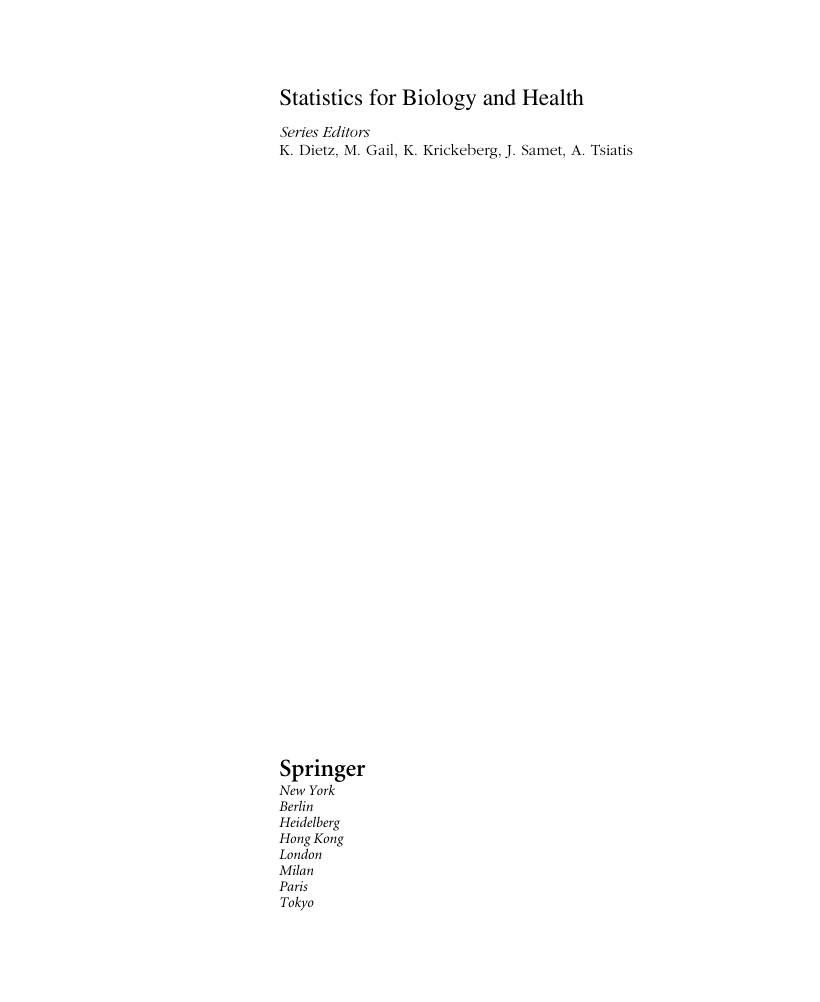

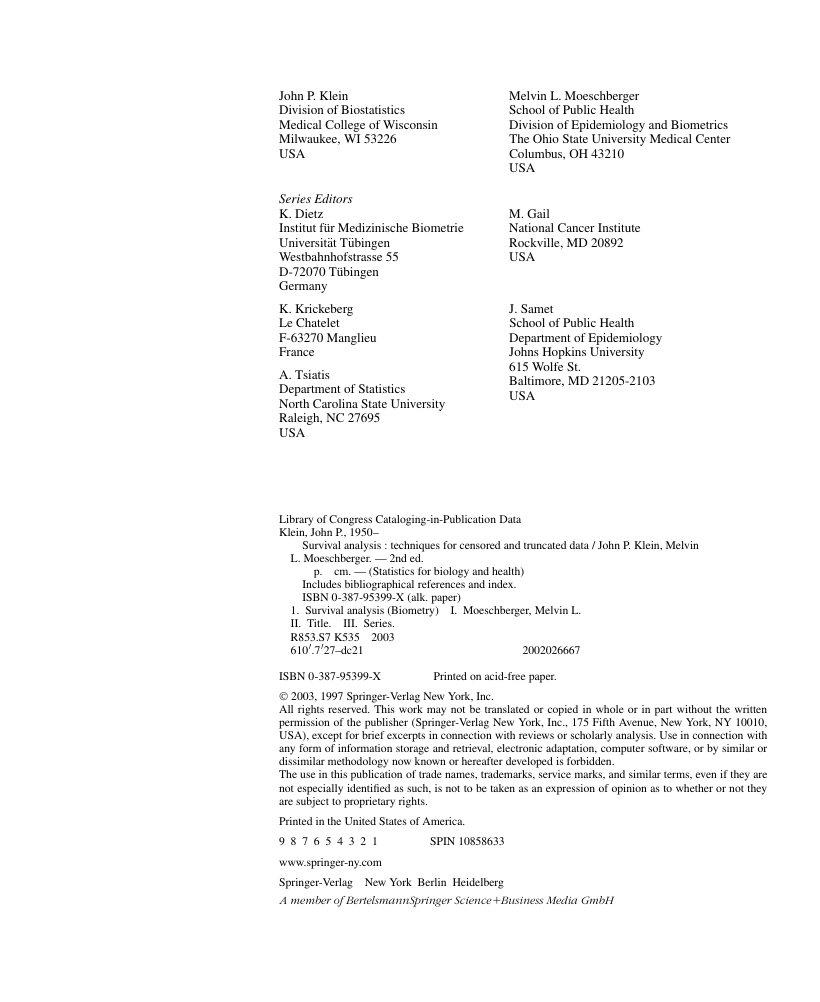
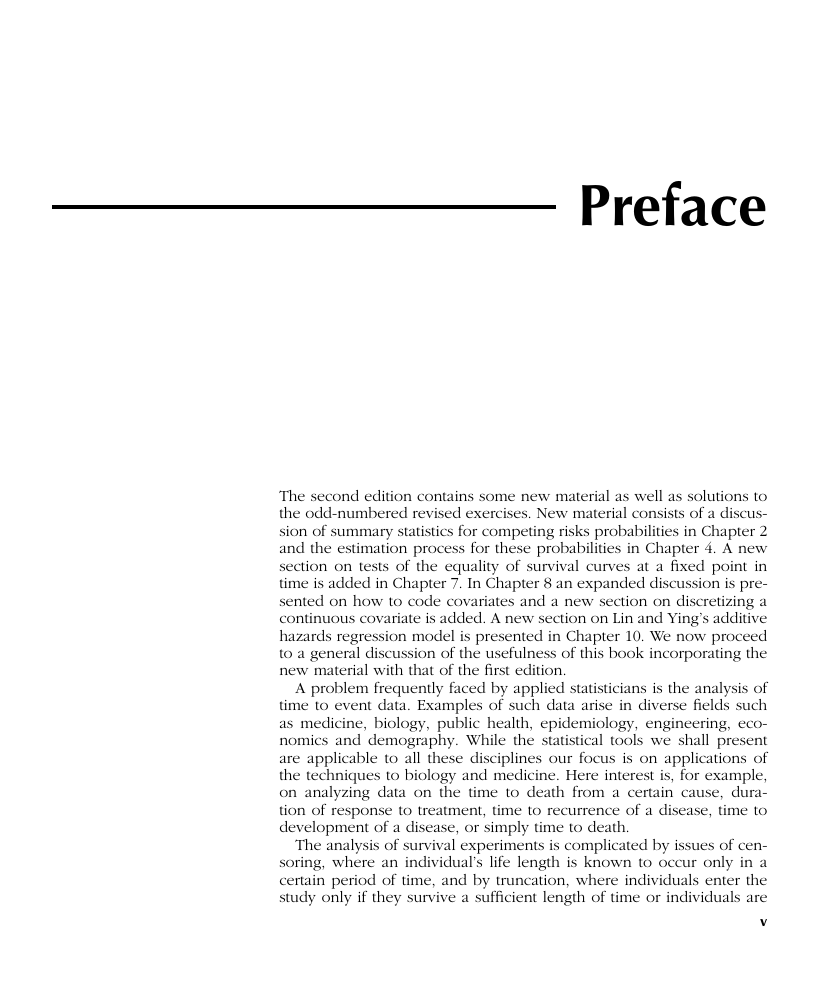
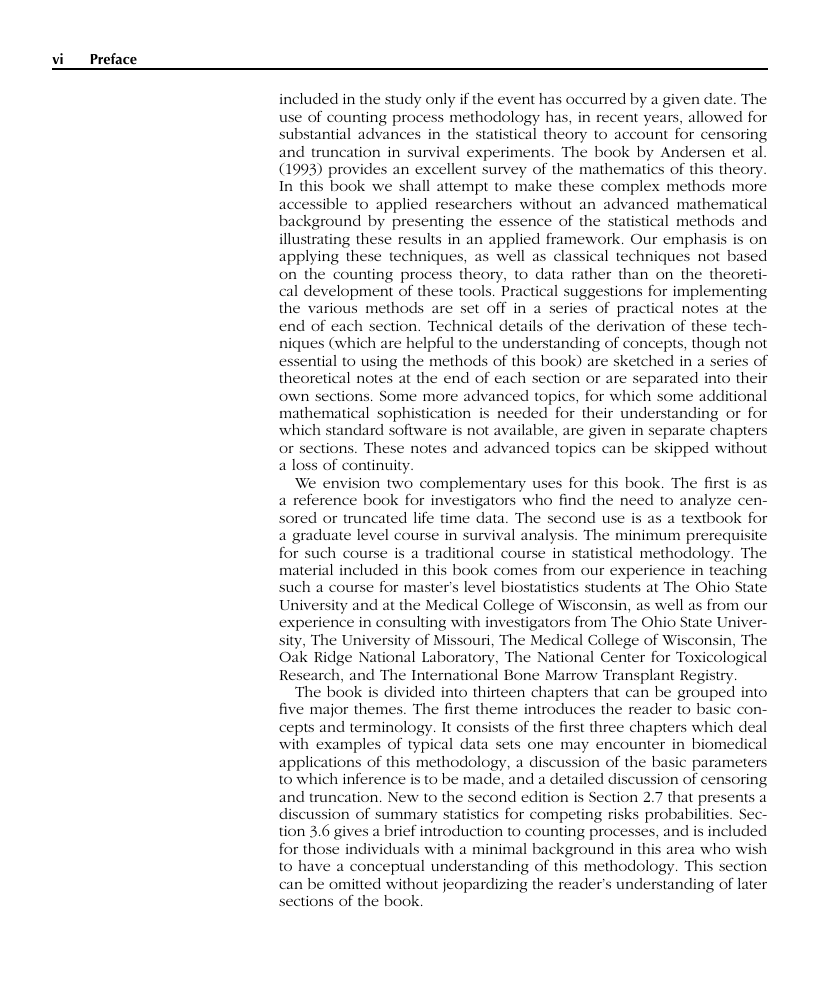

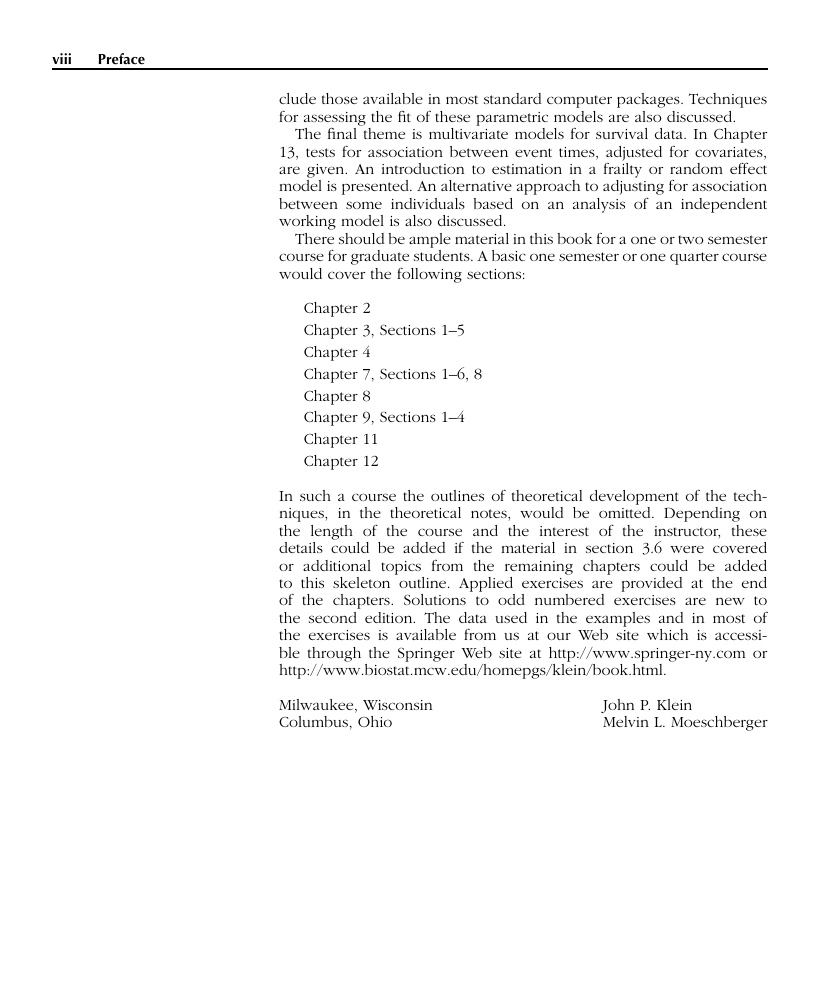









 2023年江西萍乡中考道德与法治真题及答案.doc
2023年江西萍乡中考道德与法治真题及答案.doc 2012年重庆南川中考生物真题及答案.doc
2012年重庆南川中考生物真题及答案.doc 2013年江西师范大学地理学综合及文艺理论基础考研真题.doc
2013年江西师范大学地理学综合及文艺理论基础考研真题.doc 2020年四川甘孜小升初语文真题及答案I卷.doc
2020年四川甘孜小升初语文真题及答案I卷.doc 2020年注册岩土工程师专业基础考试真题及答案.doc
2020年注册岩土工程师专业基础考试真题及答案.doc 2023-2024学年福建省厦门市九年级上学期数学月考试题及答案.doc
2023-2024学年福建省厦门市九年级上学期数学月考试题及答案.doc 2021-2022学年辽宁省沈阳市大东区九年级上学期语文期末试题及答案.doc
2021-2022学年辽宁省沈阳市大东区九年级上学期语文期末试题及答案.doc 2022-2023学年北京东城区初三第一学期物理期末试卷及答案.doc
2022-2023学年北京东城区初三第一学期物理期末试卷及答案.doc 2018上半年江西教师资格初中地理学科知识与教学能力真题及答案.doc
2018上半年江西教师资格初中地理学科知识与教学能力真题及答案.doc 2012年河北国家公务员申论考试真题及答案-省级.doc
2012年河北国家公务员申论考试真题及答案-省级.doc 2020-2021学年江苏省扬州市江都区邵樊片九年级上学期数学第一次质量检测试题及答案.doc
2020-2021学年江苏省扬州市江都区邵樊片九年级上学期数学第一次质量检测试题及答案.doc 2022下半年黑龙江教师资格证中学综合素质真题及答案.doc
2022下半年黑龙江教师资格证中学综合素质真题及答案.doc